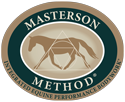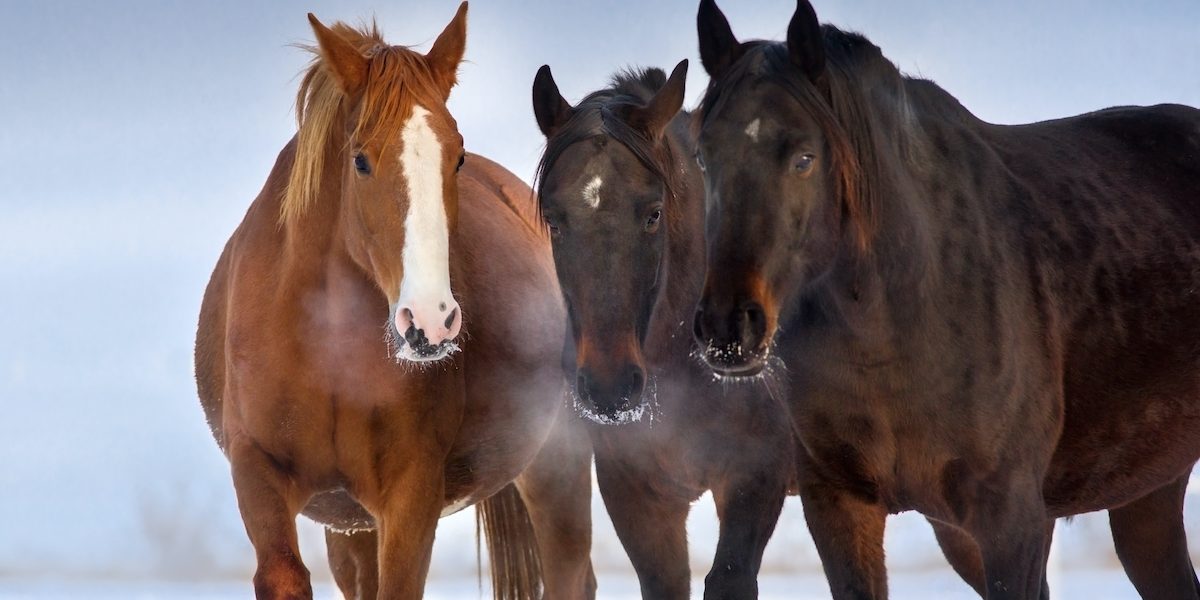The horse is the ultimate prey animal. When feeling threatened by something in the environment, he is hard-wired to run away first and ask questions later. Survival for millennia has been dependent on living in the protection of the herd. Consequently, horses try not to show discomfort in their body. They hide it until a lameness or sickness develops that they can no longer hide. This is especially true in what we commonly refer to as “stoic” horses. It isn’t that stoic horses don’t feel the discomfort. Indeed they may be more sensitive than average. They just try harder not to show the pain or weakness.
To show weakness means to likely be cast out of the herd. The predators are alert, always looking for a sign of weakness they can attack. This tendency to hide discomfort can complicate diagnosis of performance issues.
Bracing and body language
With the Masterson Method you discover areas of discomfort or tightness in the horse by observing subtle changes in the horse’s body language (often merely the blink of his eyes) during the bodywork. As you are running your hand lightly over the body or moving a part of the body such as the leg or neck through a range of motion in a relaxed state, and you observe a “blink”, it means that the horse’s body is telling you there is something there that the horse needs help with.
Naturally, if you use more pressure you can elicit bigger reactions in an area where the horse is extremely sore, such as flinching or pulling away, but by learning to observe subtler changes in the horse’s behavior you can determine both where there is discomfort, and when the horse has released it. The horse neurologically can’t stop his eye from blinking when you get near an area of special discomfort if you are using a level of pressure that he can’t brace against. With experience, you learn to recognize the blink from pain as different from the blink from a fly or other natural reasons to blink. Even a stoic horse can’t avoid releasing his tension secrets from a watchful observer. By applying similar techniques that follow subtle changes in body language and stay under the horse’s bracing response, you can get the horse to release deep-seated tension on its own.
Staying under the radar

If you have hurt your arm and you go to the doctor, you are going to naturally tense against his manipulation of your arm as he examines it. If a nurse gives you a shot, you have to fight against the natural reaction to tense against the insertion of the needle, even though you know that it will hurt more if you tighten the muscle. So it is with the horse. By “staying under the radar” we mean that the techniques of the Masterson Method are performed in such a way that the horse doesn’t brace against them. This requires feel and skill that take some time and practice to develop, but if you begin with the basics, you will get results immediately.
Naturally, horses are most likely to brace against a technique when it involves an area of discomfort. Every horse owner knows how touchy a horse can be about the poll. This is an instinctive protective reaction due to the typically high level of uncomfortable tension that is in the region of the poll. In the performance of any Masterson Method technique, you must feel when the horse is about to brace or pull back and soften first, before the bracing response happens. This is the principle of non-resistance.
The steps to getting the horse to yield to you in a relaxed state are:
1) When you ask for any movement start with the slightest amount of pressure, gradually increasing the amount with each “ask”.
2) When you sense the horse yielding the slightest bit (even thinking of shifting his weight, for example), yield immediately, then ask again right away.
3) Repeat asking in this way until the horse is yielding to you with almost no pressure/resistance at all.
If the horse resists you can gradually increase the pressure when first asking, but you must soften or yield the instant you feel any yielding from the horse. Remember, start with the softest feel possible and yield at the very first sign of the horse yielding. Often the harder you push, the harder the horse pushes back, which is the principle of non-resistance in reverse. Timing is key here. Many riders will recognize that you might already use this principle when riding.
Sidebar: Note: If the horse is resisting because there is an injury or excessive pain in an area while doing any techniques that ask for movement, he will continue resisting in order to protect the area. In any case, whenever you meet resistance, soften. In this way you run little risk of aggravating a hidden injury.
Learn more about The Masterson Method® by ordering a copy of the Beyond Horse Massage Book.
Get hands-on training at a Beyond Horse Massage Weekend Seminar near you.

